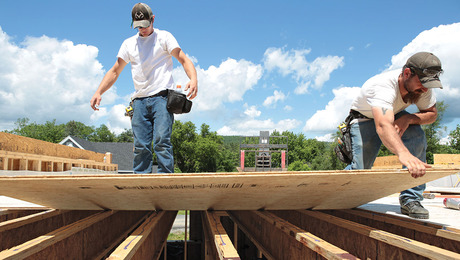Electric radiant heat in bathroom ?’s
I’m getting ready to tear up my bath floor and install a new tiled floor. The forced heat doesn’t get good pressure in the room so it’s often chilly. I want to put in electric radiant heat in there to cut the chill.
Notes:
1) first subfloor (that sits directly on joists) is plywood.
2) second “tile substrate” subfloor is 1/2″ plywood – this is the layer that I plan on removing.
3) floor space is about 7ft x 8ft
My plan was to:
1) Remove current plywood tile substrate
2) Install 1/2″ cbu instead of plywood
3) Layout down radiant heat mat and tile over
4) Radiant heat mat would be connected to a dedicated thermostat
Questions:
1) Should I put the entire room on a GFCI breaker or can I run the radiant heat mat downstream from a GFCI outlet?
I will have an outlet by the sink. I plan on running the bathroom on its own new circuit anyway (since it’s being shared with 2 bedrooms now)
2) What type of mat?
I’ve seen ones where the radiant heat mat is a mesh that can be cut and weaved around toilets and such. These are stapled down (not sure how you would do that on cbu). I’ve also seen mats are that a solid woven mat that need to be thinset down first. Any advantages of one over the other?
3) Should I use the cbu for the floor when installing the radiant heat mat? Is plywood better for this application?
I had also thought about leaving the current plywood down (if it was good enough) and laying down Ditra before tiling. Can you use Ditra with radiant heat mats? First instinct is no but I have experience in this regards.
Any other tips or advice?
Thanks in advanced.


















Replies
these heat mats don't heat the room, they only warm the floor.
I know. The room does have heat and is only slightly "cooler" than the rest of the house. The heat mat is meant to just give a nice touch to the currently cold tile. Part of my renovation will be to figure out why there is less pressure in the force air heat compared to other 2nd floor rooms. I think it's due to a bend in the duct work coming off of the main trunk in the basement.
and IMO ... bathrooms deserve to be a solid 5 deg warmer than the other rooms ... after all, you are frequently naked in them in the cold morning wanting to take a comfortable shower. If I had my druthers, I'd set the stat in the bathroom at a solid 80+ degF when the rest of the house would be at 68 degF. A warm floor does wonders for bare feet, so your concept is solid. Can't comment on your approach, though.
So do they turn off when the floor reaches a certain temp?
Yes, they have their own thermostat. In theory they should be able to heat the room, but they aren't an efficient at it.
Thermostat ... in the floor? or on the wall? The intent of radiant floors isn't to heat the room anyway, really. It is to heat ... well your feet and the objects it sees. The space temp can be 'much' cooler while maintaining comfort because of this ability to 'heat objects'. This isn't really a true radiant thing, but it has some of the similar effects.
The controller typically has a lead that goes into the floor to monitor the temperature, while the controller mounts on the wall.
When all else fails ... read the instructions!
The instructions I have seen are very clear ... they want a separate, dedicated circuit. Most of them incorporate the GFCI in their controller, so a separate GFCI is not needed.
I have two bathrooms with mats. They are great. My second floor bathroom is very warm with the mat being the only heating source. I pushed the t-stat up a few degrees above the default setting. The sensor in the floor controls the temp. You don't need a gfci, they are built into the T-stat. I got mine from warmlyours.com. There site is great because it has a section for you to lay out the whole room and get a price right away.
I followed the advice Michael Byrne wrote about in JLC about insulation.
1) Wood subfloor.
2) Primer
3) Wire or plastic mesh
4) Heating mat and sensor
5) SLC
6) Tile.
Questions:
1) Should I put the entire room on a GFCI breaker or can I run the radiant heat mat downstream from a GFCI outlet?
Put the radiant on it's own breaker
I will have an outlet by the sink. I plan on running the bathroom on its own new circuit anyway (since it's being shared with 2 bedrooms now)
2) What type of mat?
Tyco/Raychem - http://www.tycothermal.com/usa/english/floor_warming/applications/tile_floor_warming/default.aspx
View Image
View Image
3) Should I use the cbu for the floor when installing the radiant heat mat?
Yes
Is plywood better for this application? No.
I had also thought about leaving the current plywood down (if it was good enough) and laying down Ditra before tiling. Can you use Ditra with radiant heat mats? First instinct is no but I have experience in this regards.
Read Tyco site and Ditra manual - http://www.schluter.com/media/brochures/DitraHandbook-2008-ENG.pdf
Any other tips or advice?
Plan on a cost of $850 - $1150
Jeff